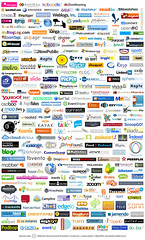 I don’t count myself among the edtech blogging scene, which is just as well, because my pedagogical insight is next to nil. I’m a technologist, not an e-learning technologist: I can talk about the social implications of the read/write web until the cows come home, but everything I know about Piaget can be written on one of the mini Post-It notes I keep next to the Professional Ajax book on my desk. There’s a whole universe of teaching and learning that I’m not aware of, although I do know some of the principles and techniques involved. I wouldn’t want to teach a class; I don’t have enough knowledge to do a decent job, and I’m not aware of all the issues involved. The other side of the coin is that although you might realise that del.icio.us exists or that WordPress is a pretty good blogging platform, you might not have considered the appropriate technological issues in order to be responsible.
I don’t count myself among the edtech blogging scene, which is just as well, because my pedagogical insight is next to nil. I’m a technologist, not an e-learning technologist: I can talk about the social implications of the read/write web until the cows come home, but everything I know about Piaget can be written on one of the mini Post-It notes I keep next to the Professional Ajax book on my desk. There’s a whole universe of teaching and learning that I’m not aware of, although I do know some of the principles and techniques involved. I wouldn’t want to teach a class; I don’t have enough knowledge to do a decent job, and I’m not aware of all the issues involved. The other side of the coin is that although you might realise that del.icio.us exists or that WordPress is a pretty good blogging platform, you might not have considered the appropriate technological issues in order to be responsible.
Education is a public service that needs to operate for the good of society. The web isn’t necessarily public service, and although a tool may be free to use, it’s almost certainly not run for the good of humankind. Google? Great search engine, invaluable for research; it’s also a multi-billion dollar business, largely based on advertising, which in turn is based on analysing your usage and serving up the commercial content they think you’re most likely to click on.
Use of these technologies in a public service environment requires some knowledge of how the data is being used. There are both legal and ethical implications. For example, if you upload videos of your class to Youtube, who can see it? If you’re a K-12 teacher, your students aren’t there out of choice; they almost certainly have to be there, by law. To then record them – be it with video, sound or photographs – and stick them online, you need to get their consent or the consent of their legal guardian. They must have the choice to keep it private, and they must be able to choose not to have their likeness potentially viewable by millions upon millions of people.
Just as you teach your students to pick their sources critically, you should pick your tools critically.
Here’s an example checklist you might want to use when selecting a web service to use in your class:
What’s the privacy policy? Are they going to use information my students create, and information about my students, for commercial purposes?
What’s the copyright policy? Are your students handing over copyright on their content? Myspace famously had to rethink its terms and conditions when it came to copyright, and it’s not alone. Youtube’s terms and conditions have a mile-high gotcha:
In its Terms & Conditions, the wildly popular video sharing site YouTube emphasizes that “you retain all of your ownership rights in your User Submissions”.
There’s quite a large “BUT…”, however. Not only does YouTube retain the right to create derivative works, but so do the users, and so too, does YouTube’s successor company.
This is probably out of whack with the copyright policies of most institutions. Particularly in higher education, copyright is very often assigned to the institution itself.
Where does the money come from? Everything needs money to survive. If you’re at an institution, you’re probably getting it through a combination of donations, public funding and fees. If you’re a web application, you’re probably getting it through investment, advertising or direct sales. Web companies are getting tens of millions of dollars in investment right now, and by and large they aren’t making it back – the Techcrunch Deadpool is a handy list of all the dead web 2.0 companies. Investment isn’t a gift; investors need to recoup their money, and particularly if there are shareholders, a company is legally obliged to seek a profit for them. Which means they could sell your details, run dubious advertising – anything they need to do to make that bottom line add up.
How can I get my data out? Because of the aforementioned funding issues, there’s a real risk of the tool you’re using going under. Imagine you had your class put something together in Jumpcut, an online video editing application, and one day it just disappeared – or you heard that in a week it was going to go offline for a while. Recently, wiki application JotSpot “went dark” after being acquired by Google, and it hasn’t resurfaced. If you can’t get your data out, it will also “go dark”.
There’s much more to consider – for example, compatibility, language issues and accessibility. It would be interesting to hear your thoughts in the comments below – should there be standards for this kind of thing, or some kind of suggested list of web applications for educators?
The famous web 2.0 logo collage is by Stabilo Boss. Can you find us?
Leave a Reply